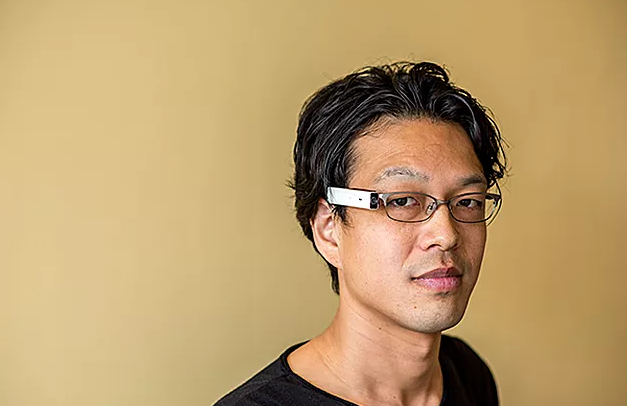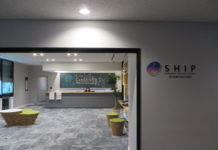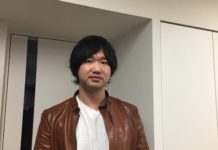We now live in a world where we take pictures with our smartphone. Whether it’s the moment spent with friends and family, the beautiful scenery on the trip you took, or the food you ate, everyone has quick draw like reflexes to take that one shot to savor for later. But what about those moments you weren’t fast enough to pull out your phone? Shota Takase, found the solution to that problem.
Introducing Blincam, a wearable camera that can be easily attached to the side of almost any eyeglass/sunglass frame. The eye movement sensor triggers the camera shutter by sensing the muscle movements at the side of your eye when you wink, allowing you to literally take pictures in the blink of an eye.
We spoke with Blincam CEO, Shota Takase about his product and how he got his start.
‐Takase-san, please tell us about your background.
I was first working at a Japanese SIer, in charge of developing financial systems at a number of onsite clients. After a few years, I wanted to work on systems on the operating company side, so I decided to change to a Large Multinational Company. Thinking about my own career advancement, I decided to attend business school while working at . It was then, I attend Startup Weekend with friends from school and was first introduced to the world of startups.
I noticed that business school students were highly skilled, basing their business plans on logic. On the other hand, acquaintances that I made at Startup Weekend were focused mainly on execution. I thought it would be interesting to form a community between the two sides, so my business school starting hosting startup events. From there, I started participating in Startup Weekend as an event organizer. I decided to start my own company, from the various relationships formed and knowledge gained through event organizing.
‐When and why did you decide to start your business?
Last April at an IoT themed Startup Weekend event, as a facilitator, I was able to meet with a number of hardware startups and specialists beforehand and while preparing for the event, I thought that there is still room for entry into the hardware and wearable market. I also thought that if I were able to create a team of engineers specializing in the field, with would be difficult for rivals to compete. At the time, I had very little experience with hardware, but started by pitching my Blincam idea to various participants.

‐How did you deal with funding? Were you able to receive funding in the past?
At first, starting out with three people, including myself, we thought about putting up some of our funds to create a company, building a mockup, then going the crowd funding route. However, it didn’t work out as easy as we first expected (Takase laughs). While trying to keep ahead of our own living expenses, we were able to finally start production after pitching at multiple venues and being introduced to various people. We were able to finish beta version testing around spring this year and finally applied for crowd funding via Makuake in July. Beyond our expectations, we have been since covered by many media outlets. We were able to also receive funding from a number of angel investors, but not any venture capital firms as of yet.
‐Who are your target customers and how do you differentiate yourself from your competitors?
A camera that allows you to take a picture with a wink is a catchy concept and unique within the consumer devices space, so we are expecting a large buzz. We could see wearable cameras like Go Pro as a competitor, but there is nothing in the market at the moment like Blincam.
‐What are your plans for expansion in the future? Also, are you thinking of expanding overseas?
At first we thought about starting out overseas, but through the various relationships we were able to build locally, we decided to start from Japan. However, since being picked up by many foreign media outlets like CNET, CNBC, and CNN, we have been receiving a lot of inquiries from America, as well as Taiwan and other South East Asian countries. Because of the press that we’ve received, we are expecting our main market to be in America, particularly on the west coast where new gadgets trend quickly.
‐In the future, what types of investors or companies would you like to connect with?
In next stage when we go to mass production, it would be great to receive funding from investors in the US, since America will be our main market. However, I understand there will be some roadblocks to this, so we will soon start crowd funding through Indigogo to gain more attention. However, whether we receive funding through Japanese or American sources, we want to weigh our options at this stage. Even if we take the Japan route, we would like it to be understood that we are going global with our product.
‐Tell us about your daily schedule.
I wake up at 4-5 am and first check my mail. I have frequent meetings with America in the morning, so I go to bed early and wake up early. After that, I take my child to nursery school and in the office by around 10 am. I have many appointments and meetings in the afternoon along with other work to tackle and usually get back home by 10 pm if I have meetings at night or dinner appointments.
‐What is the app you most frequently use?
I use messenger apps, such as LINE, and for work mostly use Slack.
‐Tell us about your favorite hangout.
I like the Okinawan restaurant near my house; the food is good, cheap, and often go there with my family. That’s the place I give my status report to my wife (Takase chuckles); I don’t get catch up with her since I so busy usually.
For work, I am usually at cafes such as Starbucks or Doutor.
‐Who are you influenced by the most?
I know it may not sound original, but in a broad sense, can say I have been influenced by Steve Jobs through books and his sayings.
As far as people within my own circle, I would say Startup Weekend head, Lee-san. Whether it was about startup events held at my business school or about my own startup, he has always been there to share his advice and I see him a major influence up until now.
After seeing the product for the first time, it was hard to imagine it being a camera, due to its lightweight design and miniature size. While taking pictures of your own children immediately comes to mind, we see other practical uses for Blincam, such as making a step by step recipe guide while cooking, or used while riding a bike or skiing. Following suit to US trends, we see a high possibility of the Blincam buzz to spreading to Japan soon.



















